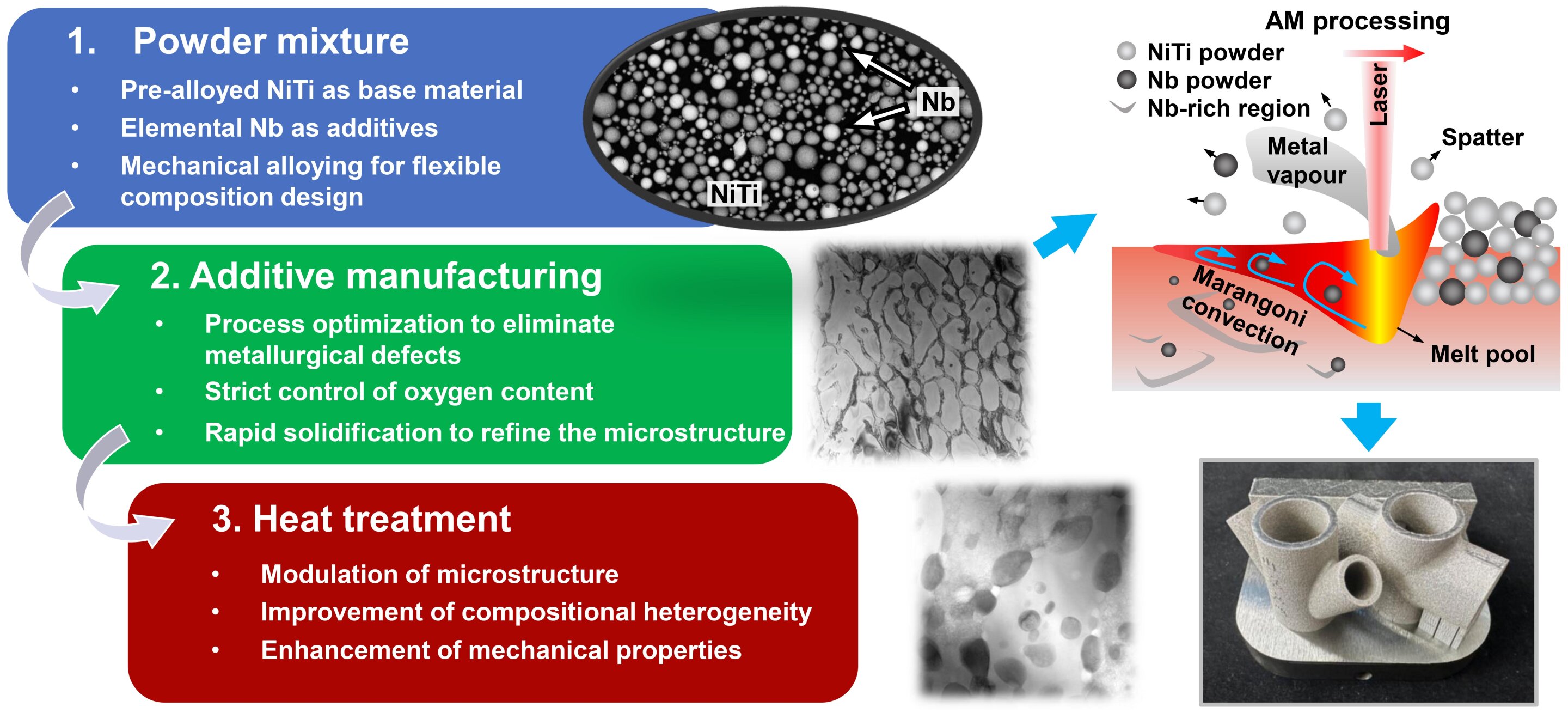
In order to address the challenges in fabrication NiTiNb ternary alloy structures, researchers from Shandong University (SDU) have proposed an alloy design strategy to prepare NiTiNb shape memory alloys (SMAs) through laser powder bed fusion in-situ alloying and post-heat treatment. The in-situ alloyed NiTiNb alloy shows typical transformation characteristics (e.g. wide hysteresis) and good mechanical/functional properties.
The work, reported in the International Journal of Extreme Manufacturing, could accelerate the development of high-performance NiTi-based SMAs, and facilitate the fabrication of additively manufactured smart structures.
NiTi-based SMAs are attracting growing attention in biomedical, aerospace, and automotive industries due to their unique shape memory effect and superelasticity. However, the difficulties faced in conventional casting and machining have limited their widespread use, especially for those with complex geometries.
"Additive manufacturing (AM) technology is an ideal method for solving the processing challenges of NiTi-based SMAs," said Xiebin Wang, corresponding author on the paper and Professor in the School of Materials Science and Engineering at SDU.
"In most cases, AM technology has been focused on its ability to prepare complex structures, while its capabilities as a metallurgical tool have been overlooked. In order to develop novel NiTi-based smart structures, we need to find a way to integrate material synthesis and structure forming.
"Here we're saying, why not use mixed powders as feedstocks instead of pre-alloyed powders, which would shorten the development cycle of new alloys? Are additional means (e.g., post-heat treatment) needed to further enhance the mechanical properties of the additively manufactured parts?"
In the past decades, a few preliminary studies have been conducted on the in-situ alloying of NiTi-based SMAs through AM, but the as-fabricated alloys always show highly heterogeneous microstructures and poor mechanical properties.
Because of the rapid solidification characteristics and complex thermal histories, the morphology of eutectic structures of the additively manufactured (AMed) NiTiNb SMAs is quite distinct from that of conventionally prepared parts.
The existing heat treatment regimes for conventional alloys are not always compatible with the AMed alloys due to the differences in initial microstructure. There is an urgent need to understand the influence of post-heat treatment on the AMed NiTiNb alloys.
The SDU researchers used the pre-alloyed NiTi powders as base materials to ensure the formation of primary NiTi phase, and added 9 at.% elemental Nb powders, aiming to widen the thermal hysteresis. The optimized AM process parameter was used to produce dense NiTiNb parts. A high-temperature (1273K) solution treatment with different holding time was designed to improve the mechanical/functional performances of the AMed NiTiNb alloys.
The researchers conducted a comprehensive investigation on the effect of solution treatment on the microstructure, phase transformation behavior and mechanical/functional performances of the AMed NiTiNb alloys. They also discussed the mechanisms behind the microstructure evolution, transformation behavior modulation and enhancement of mechanical performances.
"The biggest advantage for this alloy design route is the integration of material synthesis and net-shaping of complex geometries," said Xiebin Wang, "Combining the forming and metallurgical advantages of additive manufacturing technology with the functional properties of NiTi-based SMAs will create new opportunities for the development of novel smart structures."
The researchers are continuing the work, hoping to improve the mechanical properties of the NiTi-based SMAs comparable to those of wrought parts, for example, through hot isostatic pressing. They are also attempting to apply this route to develop other NiTi-based ternary or quaternary SMAs.
More information: Rui Xi et al, Effect of solution treatment on the microstructure, phase transformation behavior and functional properties of NiTiNb ternary shape memory alloys fabricated via laser powder bed fusion in-situ alloying, International Journal of Extreme Manufacturing (2024). DOI: 10.1088/2631-7990/ad35fc
Provided by International Journal of Extreme Manufacturing
Citation: In-situ alloying of NiTiNb shape memory alloys by additive manufacturing (2024, April 16) retrieved 16 April 2024 from https://techxplore.com/news/2024-04-situ-alloying-nitinb-memory-alloys.html
This document is subject to copyright. Apart from any fair dealing for the purpose of private study or research, no part may be reproduced without the written permission. The content is provided for information purposes only.
